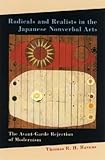Radicals and Realists in the Japanese Nonverbal Arts : The Avant-Garde Rejection of Modernism / Thomas R. H. Havens.
Material type: TextPublisher: Honolulu : University of Hawaii Press, [2006]Copyright date: ©2006Description: 1 online resource (320 p.) : 34 illus, 10 in colorContent type:
TextPublisher: Honolulu : University of Hawaii Press, [2006]Copyright date: ©2006Description: 1 online resource (320 p.) : 34 illus, 10 in colorContent type: - 9780824842048
- 700
- online - DeGruyter
| Item type | Current library | Call number | URL | Status | Notes | Barcode | |
|---|---|---|---|---|---|---|---|
 eBook
eBook
|
Biblioteca "Angelicum" Pont. Univ. S.Tommaso d'Aquino Nuvola online | online - DeGruyter (Browse shelf(Opens below)) | Online access | Not for loan (Accesso limitato) | Accesso per gli utenti autorizzati / Access for authorized users | (dgr)9780824842048 |
Frontmatter -- Contents -- List of Illustrations -- Preface -- Introduction: Postwar Vectors in the Japanese Nonverbal Arts -- 1. The Occupation and Modernity -- Part One: Experimental Voyages: The 1950s -- Overview -- 2. The Experimental Workshop -- 3. Avant-Garde Visual Culture: Local and Historical -- 4. Concrete Abstractions, Abstract Expressions -- 5. The Sogetsu Art Center: Avant-Garde Refinement -- Part Two: Alternate Modernities in the 1960s: Locating the Everyday -- Overview -- 6. Beyond Form and Formality -- 7. Events, Objects and Concepts -- 8. Contemporary Art Music and Dance in the 1960s: Transcultural Idioms -- 9. The Monoha Moment -- 10. Art, Money, and Politics -- 11. Radicals and Realists -- Notes -- Sources Cited -- Index
restricted access online access with authorization star
http://purl.org/coar/access_right/c_16ec
Radicals and Realists is the first book in any language to discuss Japan's avant-garde artists, their work, and the historical environment in which they produced it during the two most creative decades of the twentieth century, the 1950s and 1960s. Many of the artists were radicals, rebelling against existing canons and established authority. Yet at the same time they were realists in choosing concrete materials, sounds, and themes from everyday life for their art and in gradually adopting tactics of protest or resistance through accommodation rather than confrontation. Whatever the means of expression, the production of art was never devoid of historical context or political implication. Focusing on the nonverbal genres of painting, sculpture, dance choreography, and music composition, this work shows that generational and political differences, not artistic doctrines, largely account for the divergent stances artists took vis-a-vis modernism, the international arts community, Japan's ties to the United States, and the alliance of corporate and bureaucratic interests that solidified in Japan during the 1960s.After surveying censorship and arts policy during the American occupation of Japan (1945-1952), the narrative divides into two chronological sections dealing with the 1950s and 1960s, bisected by the rise of an artistic underground in Shinjuku and the security treaty crisis of May 1960. The first section treats Japanese artists who studied abroad as well as the vast and varied experiments in each of the nonverbal avant-garde arts that took place within Japan during the 1950s, after long years of artistic insularity and near-stasis throughout war and occupation. Chief among the intellectuals who stimulated experimentation were the art critic Takiguchi Shuzo, the painter Okamoto Taro, and the businessman-painter Yoshihara Jiro. The second section addresses the multifront assault on formalism (confusingly known as "anti-art") led by visual artists nationwide. Likewise, composers of both Western-style and contemporary Japanese-style music increasingly chose everyday themes from folk music and the premodern musical repertoire for their new presentations. Avant-garde print makers, sculptors, and choreographers similarly moved beyond the modern-and modernism-in their work. A later chapter examines the artistic apex of the postwar period: Osaka's 1970 world exposition, where more avant-garde music, painting, sculpture, and dance were on display than at any other point in Japan's history, before or since.Radicals and Realists is based on extensive archival research; numerous concerts, performances, and exhibits; and exclusive interviews with more than fifty leading choreographers, composers, painters, sculptors, and critics active during those two innovative decades. Its accessible prose and lucid analysis recommend it to a wide readership, including those interested in modern Japanese art and culture as well as the history of the postwar years.
Mode of access: Internet via World Wide Web.
In English.
Description based on online resource; title from PDF title page (publisher's Web site, viewed 02. Mrz 2022)


